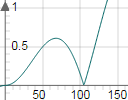IntMath Newsletter: Ellipse, IQ, mobile mystery
By Murray Bourne, 16 Oct 2014
16 Oct 2014
In this Newsletter:
1. New ellipse animation
2. IQ and how we see the world
3. Mystery - mobile and desktop visitors
4. How to code JSXGraph axes, ticks and grids
5. Friday math movie - Music and math: The genius of Beethoven
6. Math puzzles
7. Final thought - inequality
1. New ellipse animation
The above animation is simple and doesn't do much. You may find the following more interactive and useful for learning about ellipses:
2. IQ and how we see the world
In a 2013 study by the University of Rochester, researchers found interesting differences between the way high IQ people perceive different sized objects. In the summary, "People with high IQs process sensory information differently" (no longer available), we read:
"It is not that people with high IQ are simply better at visual perception," says Duje Tadin of the University of Rochester. "Instead, their visual perception is more discriminating. They excel at seeing small, moving objects but struggle in perceiving large, background-like motions."
As I read more about this, I thought about how it affects success in mathematics study, especially in word problems.
The ability to focus on the important small details, and ignore the larger, distracting unimportant details bodes well for students, researchers, and all of us who are daily swamped with information overload.
Here is the original Rochester University journal article:
A strong interactive link between sensory discriminations and intelligence
Do you know your IQ?
In my school system, our IQ was tested, but we were never told what it was. The teachers didn't want us to either feel despondent and unmotivated if we had a low IQ score, or to be lazy because we knew we had a high score.
Do you know your own IQ? Has it affected your approach to learning? Do you feel it really matters?
Leave your responses here.
3. Mystery - mobile and desktop visitors
As you may know, IntMath presents a mobile version of the site to users with mobile phones.
For a while now, I've noticed differences in traffic betwen mobile and desktop visitors to IntMath.
All things being equal, you would expect users to be interested in the same math topics, no matter what device they are using for access. But this is not the case.
I have color-coded the following table (yellow for algebra topics, green for graphs, pink for probability and orange for calculus).
Rank 6 is the only case where traffic rank is represented by the same page.
This is taken from the most recent 500,000 page views.
| Rank | (Desktop/tablet) Pages | # views | (Mobile) Pages | # views |
|---|---|---|---|---|
| 1 | Problem Solver | 25749 | Domain and Range | 9413 |
| 2 | Domain and Range | 20854 | Home page | 6571 |
| 3 | How to find the Equation of a Quadratic Function from its Graph | 15490 | Derivative of sin, cos and tan | 5887 |
| 4 | Derivative of sin, cos and tan | 14536 | Basic Algebra Introduction | 4250 |
| 5 | Home page | 12655 | Derivative of csc sec and cot | 3318 |
| 6 | Derivative of Logarithms | 10392 | Derivative of Logarithms | 3288 |
| 7 | Poisson Distribution | 9603 | Matrices and Determinants Introduction | 2605 |
| 8 | Solving Differential Equations | 9067 | Perpendicular distance point to a line | 2564 |
| 9 | Normal Probability Distribution | 8741 | Exponents and Radicals | 2462 |
| 10 | Graphs Sine & Cosine - Amplitude | 7627 | Factoring and Fractions | 2456 |
(Most tablet users go to the desktop version of the site, so they are included in desktop figures.)
The Problem Solver does not have a mobile version, so that explains why it doesn't appear in the mobile column.
But overall, it's a mystery to me. Why are desktop users interested in finding out about quadratic graph functions, where mobile users are not as much? Why are mobile users more interested in algebra topics than desktop users? Is this an age issue, perhaps?
Do you have your own hypothesis? Leave your ideas here.
4. How to code JSXGraph axes, ticks and grids
This is a technical article and is for those who want to create their own graphs on Web pages.
 |
Trying to code JSXGraph so the axes and grid lines work can be a battle. This article points to a summary with examples of how to do it. |
5. Friday math movie - Music and math: The genius of Beethoven
 |
Did Beethoven use math to create music when he was going deaf? This video is part of a TEDEd lesson. |
6. Math puzzles
The puzzle in the last IntMath Newsletter asked which is the next image in a given series. The correct answer with explanation was given by Felix and Nicos. (Chris and Sachin had "almost" correct answers.)
Pattern recognition questions often seem to have more than one correct answer, depending on how good the reasoning is. But in this case, answer (b) is the only one that stands up to scrutiny.
New math puzzle: A beaker contains 250 mL of gasoline. A small cup is used to scoop gasoline out of the beaker and that gasoline is replaced by a cup of oil. The process is repeated, and it is found the final gasoline to oil mix is in the ratio 16:9. What is the capacity of the small cup?
Leave your responses here.
7. Final thought - inequality
Today is Blog Action Day, where bloggers all over the world join together to provide insight into a particular theme. This year, the topic is inequality, and articles I've seen so far concentrate on income, gender and racial inequality.
But since "inequality" is also a mathematical concept (see the chapter on Inequalities), I thought I would add some thoughts in this Newsletter.
I grew up in a country where there was relatively equal opportunity. Education was cheap and there were many choices after leaving school. It was only when I moved to Asia to live that I was confronted with serious inequalities - of opportunity, of hope, of educational and technological opportunities, and of wealth.
I also realized how different countries go about defending themselves. Most spend huge amounts on their militaries (at the cost of educational and health opportunities for their people), which they use to defend themselves from others, and from internal threats. Some countries even go looking for enemies.
Other (wiser) countries use their military to provide humanitarian aid after natural disasters (thereby making friends), as well as for defense. Such countries (which are very few), also see great value in educating their population (without prejudice to certain races, ethnic or religious groups, or gender) and provide resources to get it done, and provide a range of job opportunities.
So that's a summary of what I think is necessary to reduce the dangerous inequalities that exist in the world today - educational opportunities without prejudice against any one group of people, and job opportunities based on merit.
For some mathematical background on this issue, see Gini Coefficient of Wealth Distribution, which explains a concept we often hear about when discussing inequality.
Until next time, enjoy whatever you learn.
See the 4 Comments below.

16 Oct 2014 at 9:18 pm [Comment permalink]
Hi Murray
I sort of knew that my IQ could not be to low, because the teachers always told me I can get high scores. But I never really thought about IQ and if it was high or low.
Being a Mathematics teacher now, I sometimes wish to know the IQ of my pupils because it is not measured any more in South Africa. Parents can do it with their children, but then it is for their knowledge.
regards
Rika
18 Oct 2014 at 2:59 am [Comment permalink]
We had the same system at our school -- IQ tested but not revealed. My father was a teacher there and had a look but wouldnt tell me :(. He did say that my language score was higher than my maths haha.
This week's problem: Cup volume = 50mL
concFinal = (gas1 - cupVol*conc1 - cupVol*conc2)/volumeT
where conc2 = (gas1 - cupVol*conc1)/volumeT
16/(16+9) = (250 - v*(1) - v*((250-v*(1))/250))/250
I guess a common error would be thinking 45mL (it almost got me.) But looking at this answer does give some insight: 45mL is found by assuming that only gas is removed in the second scoop. Since this is not the case (assuming good mixing) and some of the new oil is removed the cup volume must be bigger than 45mL (but not too much)
23 Oct 2014 at 5:13 pm [Comment permalink]
Let 'x' be the volume of small cup. Then after taking out x mL of gasoline out and replacing it with oil, we are left with (250-x)mL of gasoline and x mL of oil. Again when x mL is taken out from the mixture of gasoline and oil , the gasoline left is 250((250-x)/250)^2. Similarly after n times the gasoline left will be 250((250-x)/250)^n. Therefore in the final mixture the ratio of gasoline will be 250((250-x)/250)^n = 16/25 =(4/5)^2
taking n=2
and comparing the LHS and RHS, we get x= 50mL.
15 Nov 2014 at 4:11 am [Comment permalink]
Let the cup capacity x. If the beaker's initial capacity was 250/250=1ml, then the cup would be y=x/250. One can see that each time the cup scoops out the gasoline, the quantity of the remaining gasoline follows the binomial theorem. If the cup is used n times, then the remaining gasoline is:
g=(1-y)^n ml. The corresponding amount of oil then is 1-g. But the ratio g:(1-g)=16:9. That means (1-y)^n=16/25 => y=1-(16/25)^1/n or x=250*[1-(16/25)^1/n]. For n=2 times x=50ml which provides exactly the ratio 16:9.
The capacity of the cup is 50 ml.